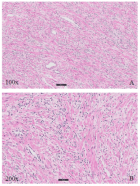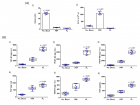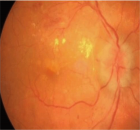Abstract
Research Article
Effect of hemodialysis session on acute changes in inflammatory and cardiovascular risk biomarkers
Bernardo-Alio Lavín Gómez*, María-Teresa García Unzueta, Armando-Raúl Guerra Ruiz, Sonia Pérez San-Martín, Ana Berja, Natalia Fañanás Rodríguez, Sara Díez Espejo and Domingo González-Lamuño Leguina
Published: 09 January, 2020 | Volume 5 - Issue 1 | Pages: 004-010
Background: Inflammation is associated with enhanced cardiovascular risk profile and increased cardiovascular mortality in end-stage kidney disease patients undergoing hemodialysis. Mechanisms of activated acute phase reaction in patients on chronic hemodialysis remain to be identified. As successful treatment of the inflammatory condition in these patients may improve long-term survival, we studied potential changes in different inflammatory biomarkers of cardiovascular risk in end-stage kidney disease patients after a mid-week hemodialysis session.
Methods: Inflammatory biomarkers of cardiovascular risk (cystatin-C, homocysteine, C-reactive protein, procalcitonin, pentraxin-3, serum amyloid-A) and atherogenic plasma lipoproteins (Lipoprotein(a), cholesterol low and high density lipoproteins) were studied in 21 end-stage kidney disease patients previously and after a mid-week hemodialysis session.
Results: We found a significant reduction in serum levels of low molecular weight molecules: cystatin-C (5.56 to 1.85 mg/L, 66.73%, p < 0.001), homocysteine (22.85 to 13.25 µmol/L, 42.01%, p < 0.001) and procalcitonin (0.788 to 0.457 ng/mL, 42.01%, p < 0.001). Large molecules as C-reactive protein (9.70 to 9.90 mg/L, 2.06%, p = 0.022) and pentraxin-3 (1.67 to 4.28 ng/mL, 156%, p < 0.001) increased, but serum amyloid-A decreased (15.90 to 12.70 mg/L, 20.13%, p < 0.05). There was no change in Lipoprotein (a) levels.
Conclusion: Pentraxin-3 was a more specific inflammatory vascular marker than C-reactive protein, and the best inflammatory marker associated with hemodialysis. Homocysteine, procalcitonin and the other small proteins could be released and removed during hemodialysis session. Further studies are needed to understand the behavior and significance of these markers after successive hemodialysis.
Read Full Article HTML DOI: 10.29328/journal.jccm.1001077 Cite this Article Read Full Article PDF
Keywords:
Biological-markers; Hemodialysis; Inflammation; Pentraxin-3 protein; Procalcitonin; Serum amyloid-A
References
- Perk J, DeBacker G, Gohlke H, Graham I, Reiner Z, et al. European Guidelines on cardiovascular disease prevention in clinical practice (version 2012). The Fifth Joint Task Force of the European Society of Cardiology and Other Societies on Cardiovascular Disease Prevention in Clinical Practice (constituted by representatives of nine societies and by invited experts). Eur Heart J. 2012; 33: 1635–1701. PubMed: https://www.ncbi.nlm.nih.gov/pubmed/22698795
- Zimmermann J, Herrlinger S, Pruy A, Metzger T, Wanner C. Inflammation enhances cardiovascular risk and mortality in hemodialysis patients. Kidney Int. 1999; 55: 648-658. PubMed: https://www.ncbi.nlm.nih.gov/pubmed/9987089
- National Cholesterol Education Program (NCEP) Expert Panel on Detection, Evaluation, and Treatment of High Blood Cholesterol in Adults (Adult Treatment Panel-lII). Third Report of the National Cholesterol Education Program (NCEP) Expert Panel on Detection, Evaluation, and Treatment of High Blood Cholesterol in Adults (ATPIII) final report. Circulation. 2002; 106: 3143-3421. PubMed: https://www.ncbi.nlm.nih.gov/pubmed/12485966
- Stone NJU, Robinson J, Lichtenstein AH, BaireyMerz CN, Blum CB, et al. 2013 ACC/AHA Guideline on the Treatment of Blood Cholesterol to Reduce Atherosclerotic Cardiovascular Risk in Adults: A Report of the American College of Cardiology/American Heart Association Task Force on Practice Guidelines. J Am Coll Cardiol. 2014; 63 (25 Pt B): 2889-2934. PubMed: https://www.ncbi.nlm.nih.gov/pubmed/24239923
- International Atherosclerosis Society (IAS) Harmonized guidelines on prevention os atherosclerotic cardiovascular diseases. 2003; http://www.athero.org/
- Inoue K, Kodama T, Daida H. Pentraxin 3: a Novel Biomarker for Inflammatory Cardiovascular Disease. Int J Vasc Med. 2012; 2012: 657025. PubMed: https://www.ncbi.nlm.nih.gov/pubmed/22347626
- Artl A, Marsche G, Sattler W, Malle E. Role of serum amyloid A during metabolism of acute-phase HDL by macrophages. Arterioscler Thromb Vasc Biol. 2000; 20: 763-772. PubMed: https://www.ncbi.nlm.nih.gov/pubmed/10712402
- Eklund KK, Niemi K, Kovanen PT. Immune functions of serum amyloid A. Crit Rev Imunol. 2012; 32: 335-348. PubMed: https://www.ncbi.nlm.nih.gov/pubmed/23237509
- Belhadj-Tahar H, Coulais Y, Tafani M, Bouissou F. Procalcitonin implication in renal cell apoptosis induced by acute pyelonephritis in children. Infect Drug Resist. 2008; 1: 17-20. PubMed: https://www.ncbi.nlm.nih.gov/pubmed/21694876
- Lavín-Gómez BA, Palomar-Fontanet R, Gago-Fraile M, Quintanar-Lartundo JA, Gómez-Palomo E, et al. Inflammation markers, chronic kidney disease, and renal replacement therapy. Adv Perit Dial. 2011; 27: 33-37. PubMed: https://www.ncbi.nlm.nih.gov/pubmed/22073825
- Peralta CA, Jacobs DR, Katz R, Ix JH, Madero M, et al. Association of pulse pressure, arterial elasticity, and endothelial function with kidney function decline among adults with estimated GFR >60 mL/min/1.73 m2: The multi-ethnic study of atherosclerosis (MESA). Am J Kidney Dis. 2012; 59: 41-49. PubMed: https://www.ncbi.nlm.nih.gov/pubmed/22000727
- Keller T, Messow CM, Lubos E, Nicaud V, Wild PS, et al. Cystatin C and cardiovascular mortality in patients with coronary artery disease and normal or mildly reduced kidney function: results from the Athero Gene study. Eur Heart J. 2009; 30: 314-320. PubMed: https://www.ncbi.nlm.nih.gov/pubmed/19153178
- Malinowska J, Kolodziejczyk J, Olas B. The disturbance of hemostasis induced by hyperhomocysteinemia; the role of antioxidants. Acta Biochim Pol. 2012; 59: 185-194. PubMed: https://www.ncbi.nlm.nih.gov/pubmed/22577622
- Wierzbicki AS. Homocysteine and cardiovascular disease: a review of the evidence.Diab Vasc Dis Res. 2007; 4: 143-150. PubMed: https://www.ncbi.nlm.nih.gov/pubmed/17654449
- Gómez-Gerique JA, López-Martínez D, Cancelas P, Montoya MT, Porres A. Expresión fenotípica de la Lp(a) en niños y adolescentes españoles. Med Clin (Bar). 2000; 114: 13-15.
- Conti G, Amore A, Chiesa M, Mancuso D, Cirina P, et al. Procalcitonin as a marker of micro-inflammation in hemodialysis. J Nephrol. 2005; 18: 282–288. PubMed: https://www.ncbi.nlm.nih.gov/pubmed/16013016
- Rysz J, Banach M, Cialkowska-Rysz A, Stolarek R, Barylski M, et al. Blood serum levels of IL-2, IL-6, IL-8, TNF-alpha and IL-1beta in patients on maintenance hemodialysis. Cell Mol Immunol. 2006; 3: 151-154. PubMed: https://www.ncbi.nlm.nih.gov/pubmed/16696903
- Trimarchi H, Dicugno M, Muryan A, Lombi F, Iturbe L, et al. Pro-calcitonin and inflammation in chronichemodialysis. Medicina (Buenos Aires). 2013; 73: 411-416. PubMed: https://www.ncbi.nlm.nih.gov/pubmed/24152395
- Katopodis KP, Koliousi E, Gouva C, Balafa O, Bairaktari E, et al. Acute effect of heparin on lipid parameters in patients on renal replacement therapy. ASAIO J. 2007; 53: 46-49. PubMed: https://www.ncbi.nlm.nih.gov/pubmed/17237649
- Lamon-Fava S, Diffenderfer MR, Marcovina SM. Lipoprotein(a) metabolism. Curr Opin Lipidol. 2014; 25: 189-193. PubMed: https://www.ncbi.nlm.nih.gov/pubmed/24751932
- Maury CP, Teppo A, Eklund B, Ahonen J. Serum amyloid A protein: a sensitive indicator of renal allograft rejection in humans. Transplantation. 1983; 36: 501–504. PubMed: https://www.ncbi.nlm.nih.gov/pubmed/6356513
- Rao M, Guo D, Perianayagam MC, Tighiouart H, Jaber BL, et al. Plasma interleukin-6 predicts cardiovascular mortality in hemodialysis patients. Am J Kidney Dis. 2005; 45: 324-333. https://www.ncbi.nlm.nih.gov/pubmed/15685511
- Snaedal S1, Heimbürger O, Qureshi AR, Danielsson A, Wikström B, et al. Comorbidity and acute clinical events as determinants of C-reactive protein variation in hemodialysis patients: implications for patient survival. Am J Kidney Dis. 2009, 53: 1024-1033. PubMed: https://www.ncbi.nlm.nih.gov/pubmed/19394732
- Meuwese CL1, Snaedal S, Halbesma N, Stenvinkel P, Dekker FW, et al. Trimestral variations of C-reactive protein, interleukin-6 and tumour necrosis factor-alpha are similarly associated with survival in haemodialysis patients. Nephrol Dial Transplant. 2011; 26: 1313-1318. PubMed: https://www.ncbi.nlm.nih.gov/pubmed/20846939
- Boehme M, Kaehne F, Kuehne A, Bernhardt W, Schröder M, et al. Pentraxin 3 is elevated in haemodialysis patients and is associated with cardiovascular disease. Nephrol Dial Transplant. 2007; 22: 2224-2229. PubMed: https://www.ncbi.nlm.nih.gov/pubmed/17496115
- Cieslik P, Hrycek A. Long PTX3 in the light of its structure, mechanism of action and clinical implications. Autoinmmunity. 2012;45: 119-128. PubMed: https://www.ncbi.nlm.nih.gov/pubmed/21988562
- Xu Y, Ding X, Zou J, Liu Z, Jiang S, et al. Plasma pentraxin3 is associated with cardiovascular disease in hemodialysis patients. Ren Fail. 2011; 33: 998-1004. PubMed: https://www.ncbi.nlm.nih.gov/pubmed/22013933
- Tong M, Carrero JJ, Qureshi AR, Anderstam B, Heimbürger O, et al. Plasma pentraxin 3 in patients with chronic kidney disease: associations with renal function, protein-energy wasting, cardiovascular disease, and mortality. Clin J Am Soc Nephrol. 2007; 2: 889-897. PubMed: https://www.ncbi.nlm.nih.gov/pubmed/17702732
- Oldani S, Finazzi S, Botazzi B, Garlanda C, Baldassarre E, et al. Plasma pentraxin-3 as a marker of bioincompatibility in hemodialysis patients. J Nephrol. 2012; 25: 120-126. PubMed: https://www.ncbi.nlm.nih.gov/pubmed/21725917
- Sjöberg B, Qureshi AR, Anderstam B, Alvestrand A, Bárány P. Pentraxin 3, a sensitive early marker of hemodialysis-induced inflammation. Blood Purif. 2012; 34: 290-297. https://www.ncbi.nlm.nih.gov/pubmed/23235124
- Yamamoto T, Nascimiento MM, Hayashi SY, Qureshi AR, Waniewski J, et al. Changes in circulating biomarkers during a single hemodialysis session. Hemodial Int. 2013; 17: 59-66. PubMed: https://www.ncbi.nlm.nih.gov/pubmed/22716238
- Nagai K, Ueda A, Saito C, Zempo-Miyaki A, Yamagata K. Annual decline in pentraxin-3 is a risk of vascular access troubles in hemodialysis patients. Int J Nephrol. 2014; 2014: 297954. PubMed: https://www.ncbi.nlm.nih.gov/pubmed/25587447
- Hansson GK, Libby P, Schönbeck U, Yan ZQ. Innate and adaptive immunity in the pathogenesis of atherosclerosis. Circ Res. 2002; 91: 281–291. PubMed: https://www.ncbi.nlm.nih.gov/pubmed/12193460
- Panichi V, Scatena A, Migliori M, Marchetti V, Paoletti S, et al. Biomarkers of Chronic Inflammatory State in Uremia and Cardiovascular Disease. Int J Inflam. 2012; 360147. PubMed: https://www.ncbi.nlm.nih.gov/pubmed/22701810
- Memoli B, Minutolo R, Bisesti V, Postiglione L, Conti A, et al. Changes of serum albumin and C-reactive protein are related to changes of interleukin-6 release by peripheral blood mononuclear cells in hemodialysis patients treated with different membranes. Am J Kidney Dis. 2002; 39: 266-273. PubMed: https://www.ncbi.nlm.nih.gov/pubmed/11840366
- Malaponte G, Libra M, Bevelacqua Y, Merito P, Fatuzzo P, et al. Inflammatory status in patients with chronic renal failure: The role of PTX3 and pro-inflammatory cytokines. Int Mol Med. 2007; 20: 471-481. PubMed: https://www.ncbi.nlm.nih.gov/pubmed/17786277
- Reis ES, DeAngelis RA, Chen H, Resuello RR, Ricklin D, Lambris JD. Therapeutic C3 inhibitor Cp40 abrogates complement activation induced by modern hemodialysis filters. Immunobiology. 2015; 220: 476-482. PubMed: https://www.ncbi.nlm.nih.gov/pubmed/25468722
Similar Articles
-
Cardiovascular damage during lupus in black African subjectsYaméogo NV*,Tougouma SJ-B,Zabsonré J,Kologo KJ,Tiemtoré WS,Kagambèga LJ,Bagbila WPAH, Traoré A,Samadoulougou AK,Zabsonré P. Cardiovascular damage during lupus in black African subjects. . 2018 doi: 10.29328/journal.jccm.1001024; 3: 031-034
-
C-reactive protein is associated with ventricular repolarization dispersion among patients with metabolic syndromeYlber Jani*,Atila Rexhepi,Bekim Pocesta,Ahmet Kamberi,Fatmir Ferati,Sotiraq Xhunga, Artur Serani,Dali Lala,Agim Zeqiri,Arben Mirto. C-reactive protein is associated with ventricular repolarization dispersion among patients with metabolic syndrome. . 2019 doi: 10.29328/journal.jccm.1001040; 4: 043-052
-
Assessment of lipid and hematological profile among blood donors in European Gaza Hospital, PalestineAhmad M Tabash*,Wesam M Afana,Abdrabbou M Elregeb,Sameer Abu Eid,Ayman M Abu Mustafa. Assessment of lipid and hematological profile among blood donors in European Gaza Hospital, Palestine. . 2019 doi: 10.29328/journal.jccm.1001043; 4: 073-079
-
Role of novel cardiac biomarkers for the diagnosis, risk stratification, and prognostication among patients with heart failureJennifer Miao,Joel Estis,Yan Ru Su,John A Todd,Daniel J Lenihan*. Role of novel cardiac biomarkers for the diagnosis, risk stratification, and prognostication among patients with heart failure. . 2019 doi: 10.29328/journal.jccm.1001049; 4: 103-109
-
Effect of hemodialysis session on acute changes in inflammatory and cardiovascular risk biomarkersBernardo-Alio Lavín Gómez*,María-Teresa García Unzueta,Armando-Raúl Guerra Ruiz,Sonia Pérez San-Martín,Ana Berja,Natalia Fañanás Rodríguez,Sara Díez Espejo,Domingo González-Lamuño Leguina. Effect of hemodialysis session on acute changes in inflammatory and cardiovascular risk biomarkers. . 2020 doi: 10.29328/journal.jccm.1001077; 5: 004-010
-
Glycosaminoglycans as Novel Targets for in vivo Contrast-Enhanced Magnetic Resonance Imaging of AtherosclerosisYavuz O Uca*,Matthias Taupitz. Glycosaminoglycans as Novel Targets for in vivo Contrast-Enhanced Magnetic Resonance Imaging of Atherosclerosis. . 2020 doi: 10.29328/journal.jccm.1001091; 5: 080-088
-
Correlation between chronic inflammation of rheumatoid arthritis and coronary lesions: “About a monocentric series of 202 cases”Nassime Zaoui*,Amina Boukabous,Nabil Irid,Nadhir Bachir,Ali Terki. Correlation between chronic inflammation of rheumatoid arthritis and coronary lesions: “About a monocentric series of 202 cases”. . 2022 doi: 10.29328/journal.jccm.1001144; 7: 109-114
Recently Viewed
-
Exophthalmos Revealing a Spheno Temporo Orbital MeningiomaHassina S*, Krichene MA, Hazil Z, Bekkar B, Hasnaoui I, Robbana L, Bardi S, Akkanour Y, Serghini L, Abdallah EL. Exophthalmos Revealing a Spheno Temporo Orbital Meningioma. Int J Clin Exp Ophthalmol. 2024: doi: 10.29328/journal.ijceo.1001055; 8: 001-003
-
Value of electrocardiographic T wave inversion in lead aVL in prediction of Mid Left Anterior Descending Stenosis in patients with stable Coronary Artery diseaseGehan Magdy*,Awad Yousef. Value of electrocardiographic T wave inversion in lead aVL in prediction of Mid Left Anterior Descending Stenosis in patients with stable Coronary Artery disease. J Cardiol Cardiovasc Med. 2017: doi: 10.29328/journal.jccm.1001015; 2: 056-062
-
Calciphylaxis in HemodialysisLuca Sgarabotto*, Paola Baldini Anastasio, Nicola Marchionna, Monica Zanella. Calciphylaxis in Hemodialysis. J Clini Nephrol. 2023: doi: 10.29328/journal.jcn.1001107; 7: 044-046
-
Metabolic syndrome: A case reportDragan Klaric,Marta Martinis*,Marta Klaric. Metabolic syndrome: A case report. Ann Clin Endocrinol Metabol. 2021: doi: 10.29328/journal.acem.1001022; 5: 031-035
-
Utilization of Molecular Simulation Applications for Stability Testing of Anthocyanin Compounds in Black ElderberryRichard Benedict*. Utilization of Molecular Simulation Applications for Stability Testing of Anthocyanin Compounds in Black Elderberry. Arch Biotechnol Biomed. 2023: doi: 10.29328/journal.abb.1001035; 7: 012-017
Most Viewed
-
Evaluation of Biostimulants Based on Recovered Protein Hydrolysates from Animal By-products as Plant Growth EnhancersH Pérez-Aguilar*, M Lacruz-Asaro, F Arán-Ais. Evaluation of Biostimulants Based on Recovered Protein Hydrolysates from Animal By-products as Plant Growth Enhancers. J Plant Sci Phytopathol. 2023 doi: 10.29328/journal.jpsp.1001104; 7: 042-047
-
Sinonasal Myxoma Extending into the Orbit in a 4-Year Old: A Case PresentationJulian A Purrinos*, Ramzi Younis. Sinonasal Myxoma Extending into the Orbit in a 4-Year Old: A Case Presentation. Arch Case Rep. 2024 doi: 10.29328/journal.acr.1001099; 8: 075-077
-
Feasibility study of magnetic sensing for detecting single-neuron action potentialsDenis Tonini,Kai Wu,Renata Saha,Jian-Ping Wang*. Feasibility study of magnetic sensing for detecting single-neuron action potentials. Ann Biomed Sci Eng. 2022 doi: 10.29328/journal.abse.1001018; 6: 019-029
-
Pediatric Dysgerminoma: Unveiling a Rare Ovarian TumorFaten Limaiem*, Khalil Saffar, Ahmed Halouani. Pediatric Dysgerminoma: Unveiling a Rare Ovarian Tumor. Arch Case Rep. 2024 doi: 10.29328/journal.acr.1001087; 8: 010-013
-
Physical activity can change the physiological and psychological circumstances during COVID-19 pandemic: A narrative reviewKhashayar Maroufi*. Physical activity can change the physiological and psychological circumstances during COVID-19 pandemic: A narrative review. J Sports Med Ther. 2021 doi: 10.29328/journal.jsmt.1001051; 6: 001-007

HSPI: We're glad you're here. Please click "create a new Query" if you are a new visitor to our website and need further information from us.
If you are already a member of our network and need to keep track of any developments regarding a question you have already submitted, click "take me to my Query."


















-zohair-moh’d-allouh.jpg)




































































































































